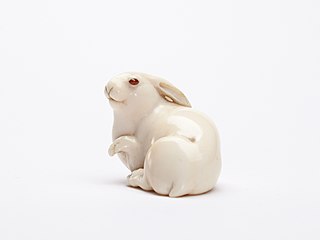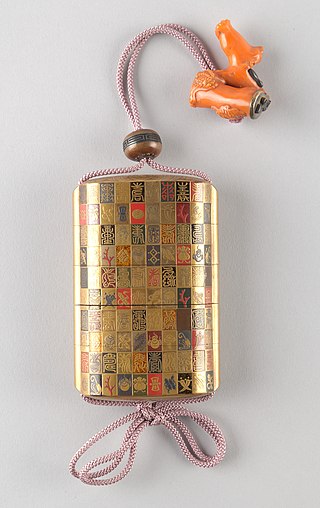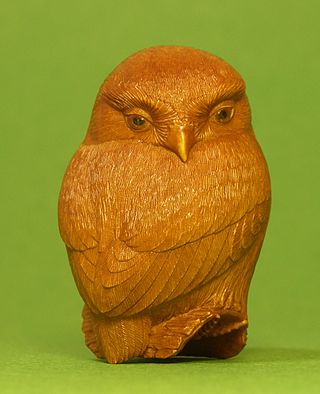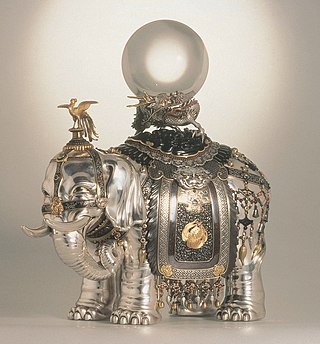Joe Earle is an author and curator. He was chair of the Asia, Oceania, and Africa department at the Museum of Fine Arts, Boston. [1] He served as Vice President and Director for the Japan Society Gallery at Japan Society from 2007 to 2011. [1]
Joe Earle is an author and curator. He was chair of the Asia, Oceania, and Africa department at the Museum of Fine Arts, Boston. [1] He served as Vice President and Director for the Japan Society Gallery at Japan Society from 2007 to 2011. [1]
Earle was educated at Westminster School and Oxford University, where he took a first in Chinese Language and Literature in 1974 and then joined the Far Eastern Department of the Victoria and Albert Museum, specializing in Japanese art and design. [2] Between 1978 and 1981 he organized the contemporary design exhibition Japan Style and served as a member of the executive and academic committees of the Great Japan Exhibition (Royal Academy of Arts, 1981-2). [3] During the same period he was responsible for the creation of a new temporary gallery of Japanese art at the V & A and an exhibition Modern Japanese Lacquer Art: A Family of Kyoto Craftsmen. [3]
In 1983 he was appointed Keeper of the Far Eastern Department, the youngest person ever to hold such a post in a U.K. national museum, [2] visited Japan for two months as a Japan Foundation Research Fellow and organized an exhibition of contemporary Japanese ceramics from the Kikuchi collection. [3] For the next three years he led the project to establish a major permanent Japanese gallery at the V & A, including fund raising, supervision of design and construction and the writing and editing of the gallery book, Japanese Art and Design. The Toshiba Gallery of Japanese Art opened in December 1986. [2]
In early 1987 he transferred at his own request to the new post of Head of Public Affairs at the V & A. [2] [3] During 1988 and 1989 he became increasingly involved in laying the groundwork for the Japan Festival 1991 and its flagship exhibition Visions of Japan, whose commissioning architect was Arata Isozaki. [2] He left the employment of the museum at the beginning of 1990 and began work as a consultant both to the V & A and to Harrison/Parrott Ltd., one of the managing agents of the Japan Festival. In addition to assuming central responsibility for Visions of Japan, he acted as Exhibitions Coordinator for the whole Japan Festival, helping to fund, organize and find venues for shows including Mingei: The Living Tradition in Japanese Art; Metropolis: Tokyo Design Visions; and an exhibition of contemporary calligraphy at the University of Ulster, Coleraine.
In 1990 he co-organized the exhibition British Design 1790–1990, held at South Coast Plaza, Orange County, California. He was responsible for the 1992–94 European tour of Songs of My People , an exhibition, sponsored by TimeWarner Inc., of photographs of African-American life by African American photojournalists.
In 1997 he assisted the Courtauld Institute Galleries in their negotiations with Nihon Keizai Shimbun Inc. for the loan of impressionist paintings to Japan, curated an exhibition of the works of Shibata Zeshin at the National Museums of Scotland, and started work on a large-scale exhibition of Japanese decorative art of the Meiji period (1868–1912) from the collection of Dr. David Khalili which was shown first in Wilmington, Delaware in 1999 and then, in a revised form and with a new catalogue, at the Portland (Oregon) Museum of Art from June to September 2002. In 2001 he organized a major exhibition of the textile artist and Living National Treasure Serizawa Keisuke held at the National Museums of Scotland as part of the nationwide Japan 2001 season, and completed work on Netsuke: Fantasy and Reality in Japanese Miniature Sculpture which was shown at the Museum of Fine Arts, Boston from September 2001 to November 2002. [4] [2]
In February 2002 he was commissioned by Lady Sainsbury to organize an exhibition in Japan of the work of the British contemporary potter Rupert Spira which opened on October 25 2003. Starting April 2002 he was tasked by Museum of Fine Arts, Boston to computer-catalogue the museum’s extensive collection of Japanese metalwork, [4] [2] and sagemono craftwork[ citation needed ], as well as 50,000 pieces of ukiyo-e in the collection which were then made available for viewing on the web. [3]
He also conducted initial research towards a possible exhibition of the ceramics of Tomimoto Kenkichi in the U.K. and U.S. and played a part in preliminary negotiations for the Khalili collection to tour in Japan. From 1998 to 2003 he was consultant to the Japanese Department of Christie, Manson & Woods Ltd. and wrote or edited a substantial part of Christie’s regular London catalogues as well as special catalogues including the Manno Collection (June 2001) and An Important European Collection of Netsuke (November 2001). He was a Trustee of the Design Museum, London from 1987 until 2002 and has been a member of the Advisory Panel of the National Art Collections Fund since 1996. He also served on the Steering Committee of Japan 2001.
In February 2003, Joe Earle was named as first Chair of the Department of Art of Asia, Oceania and Africa at the Museum of Fine Arts, Boston, and took up his post in August of the same year. [4] [2] On September 4, 2007, Joe Earle took the post of Vice-President and Director of the Japan Society Gallery at Japan Society. [3] He retired in 2011. [1]
Joe Earle has edited, written or contributed to many substantial publications on Japanese art, including:

The Meiji era is an era of Japanese history that extended from October 23, 1868 to July 30, 1912. The Meiji era was the first half of the Empire of Japan, when the Japanese people moved from being an isolated feudal society at risk of colonization by Western powers to the new paradigm of a modern, industrialized nation state and emergent great power, influenced by Western scientific, technological, philosophical, political, legal, and aesthetic ideas. As a result of such wholesale adoption of radically different ideas, the changes to Japan were profound, and affected its social structure, internal politics, economy, military, and foreign relations. The period corresponded to the reign of Emperor Meiji. It was preceded by the Keiō era and was succeeded by the Taishō era, upon the accession of Emperor Taishō.

Japanese art covers a wide range of art styles and media, including ancient pottery, sculpture, ink painting and calligraphy on silk and paper, ukiyo-e paintings and woodblock prints, ceramics, origami, and more recently manga and anime. It has a long history, ranging from the beginnings of human habitation in Japan, sometime in the 10th millennium BCE, to the present day.

A netsuke is a miniature sculpture, originating in 17th century Japan. Initially a simply-carved button fastener on the cords of an inrō box, netsuke later developed into ornately sculpted objects of craftsmanship.

Japonisme is a French term that refers to the popularity and influence of Japanese art and design among a number of Western European artists in the nineteenth century following the forced reopening of foreign trade with Japan in 1858. Japonisme was first described by French art critic and collector Philippe Burty in 1872.

Sculpture in Japan began with the clay figure. Towards the end of the long Neolithic Jōmon period, some pottery vessels were "flame-rimmed" with extensions to the rim that can only be called sculptural, and very stylized pottery dogū figures were produced, many with the characteristic "snow-goggle" eyes. During the Kofun period of the 3rd to 6th century CE, haniwa terracotta figures of humans and animals in a simplistic style were erected outside important tombs. The arrival of Buddhism in the 6th century brought with it sophisticated traditions in sculpture, Chinese styles mediated via Korea. The 7th-century Hōryū-ji and its contents have survived more intact than any East Asian Buddhist temple of its date, with works including a Shaka Trinity of 623 in bronze, showing the historical Buddha flanked by two bodhisattvas and also the Guardian Kings of the Four Directions.

The Shijō school, also known as the Maruyama–Shijō school, was a Japanese school of painting.

An inro is a traditional Japanese case for holding small objects, suspended from the obi (sash) worn around the waist when wearing a kimono. They are often highly decorated with various materials such as lacquer and various techniques such as maki-e, and are more decorative than other Japanese lacquerware.
Shibata Zeshin was a Japanese lacquer painter and print artist of the late Edo period and early Meiji era. He has been called "Japan's greatest lacquerer", but his reputation as painter and print artist is more complex: In Japan, he is known as both too modern, a panderer to the Westernization movement, and also an overly conservative traditionalist who did nothing to stand out from his contemporaries. Despite holding this complicated reputation in Japan, Zeshin has come to be well regarded and much studied among the art world of the West, in Britain and the United States in particular.

Lacquerware is a Japanese craft with a wide range of fine and decorative arts, as lacquer has been used in urushi-e, prints, and on a wide variety of objects from Buddha statues to bento boxes for food.

Sir Nasser David Khalili KCSS PhD is a British-Iranian scholar, collector, and philanthropist based in London. Born in Iran and educated at Queens College, City University of New York and the School of Oriental and African Studies in London, he is a naturalised British citizen.

The Pavilion for Japanese Art is a part of the Los Angeles County Museum of Art containing the museum's collection of Japanese works that date from approximately 3000 BC through the 20th century AD. The building itself was designed by renowned architect Bruce Goff.

Nick Lamb is a sculptor specialising in the Japanese art form of netsuke. One of a handful of non-Japanese carvers of netsuke, Lamb has built a reputation since the 1980s as one of the best living practitioners of this art. He is known for meticulous, graceful carvings, typically of animals. His preferred medium for carving is boxwood. Lamb was born in 1948 in Cambridge, England, and educated at Berkshire College, Maidenhead, Berkshire, England. He originally trained as a graphic designer, and was introduced to netsuke by someone who had seen a miniature carving he had done as a pastime. He began to carve full-time in 1988 and moved to the United States in 1995 to be closer to fellow carvers and netsuke collectors.

A kōbako (香箱) is an incense storage box used in kōdō, the traditional Japanese art which involves using and appreciating incense within a structure of codified conduct. It can be used to store the items needed for the incense-comparing games. called kumikō (組香) and genjikō (源氏香). The similar word kobako means "small box" in Japanese.

Ando Jubei (1876–1956) was a Japanese cloisonné artist from Nagoya. Along with Hayashi Kodenji, he dominated Nagoya's enameling industry in the late Meiji era. Ando, Namikawa Yasuyuki, and Namikawa Sōsuke are considered the three artists whose technical innovations brought in the "Golden Age for Japanese cloisonné" in the late 19th century.
Kawade Shibatarō was a Japanese artist working in shippo. As head of the Ando Cloisonné Company, he introduced a number of technical innovations, expanding the colours that could be rendered in enamel and bringing the company to a new level of success. Under his leadership, the company exhibited at world's fairs, winning multiple awards. It was also appointed as an official supplier of cloisonné works for the Japanese imperial family.

The Khalili Collections are eight distinct art collections assembled by Nasser D. Khalili over five decades. Together, the collections include some 35,000 works of art, and each is considered among the most important in its field.

The Khalili Collection of Japanese Art is a private collection of decorative art from Meiji-era (1868–1912) Japan, assembled by the British-Iranian scholar, collector and philanthropist Nasser D. Khalili. Its 1,400 art works include metalwork, enamels, ceramics, lacquered objects, and textile art, making it comparable only to the collection of the Japanese imperial family in terms of size and quality. The Meiji era was a time when Japan absorbed some Western cultural influences and used international events to promote its art, which became very influential in Europe. Rather than covering the whole range of Meiji-era decorative art, Khalili has focused on objects of the highest technical and artistic quality. Some of the works were made by artists of the imperial court for the Great Exhibitions of the late 19th century. The collection is one of eight assembled, published, and exhibited by Khalili.

The Khalili Imperial Garniture is a trio of cloisonné vases created for a Japanese Imperial commission during the Meiji era. The items were exhibited at the World's Columbian Exposition in Chicago, United States, in 1893, where they were described as "the largest examples of cloisonné enamel ever made". The decoration of the vases represents virtues and the seasons, and also has an allegorical meaning about Japan's role in a changing world and its alliance with the United States. After being exhibited, the vases were separated from each other for more than 120 years, eventually reunited in 2019 in the Khalili Collection of Japanese Art, a private collection assembled by the British-Iranian collector and scholar Nasser D. Khalili.
Yabu Meizan was a Japanese artist and workshop owner known for painting on porcelain. His studio produced high-end Satsuma ware, primarily for the export market. That term was originally coined for artistic painted porcelain from the Satsuma Province. Eventually it expanded to include low-quality porcelain that was mass-produced for export, whereas Meizan was one of the artists who continued the tradition of high artistic quality while also successfully exporting. He is regarded as the "prince" of this medium and today his works are sought after by collectors.

The Nasser D. Khalili Collection of Islamic Art includes 28,000 objects documenting Islamic art over a period of almost 1400 years, from 700 AD to the end of the twentieth century. It is the largest of the Khalili Collections: eight collections assembled, conserved, published and exhibited by the British-Iranian scholar, collector and philanthropist Nasser David Khalili, each of which is considered among the most important in its field. Khalili's collection is one of the most comprehensive Islamic art collections in the world and the largest in private hands.